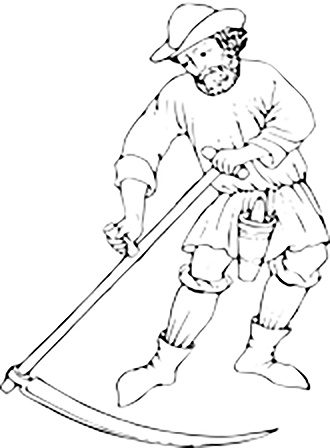
Museum archives: Tenants of the Manor
The last record of feudal obligations being insisted on in Steyning was in 1894. The owner of a cottage at Wyckham having died, his heirs were required to provide 'a heriot of a living beast' – though the owner did accept £9 in lieu in this instance.700 years ago the payment of a 'heriot' was just one of a myriad of obligations owed by the people of Steyning to the Lord of the Manor. They were spelled out in great detail in a Rental (or Custumal). Sadly that for Steyning, for that quite distant period, no longer exists – but, because that for Wiston does, we can get a fair idea of what the tenants of the manor of Steyning were obliged to do.
Drawing on the Wiston custumal we can see that in the year 1300 19 villeins – men and women who occupied the social space between free tenants and slaves – each held '1 ferling' of land. Among these were the strangely named 'Ralph Gudlak, Dionysius de la Donne, John le Rust' and 'Asselota relict of Worghte', one of four widows on the list. One ‘ferling’ was not just a 220 yard strip of land, as one might suppose if it was merely an old word for ‘furlong’: it actually seems to have approximated to 7 acres.
In return for this land they each paid rent of '8d. on the feast of St. Thomas the Apostle [December 21st] and 8d. on the feast of the Nativity of St. John the Baptist [June 24th]' plus some gifts in kind – 'he shall give at the feast of St. Thomas 1 cock and 1 hen and, at Easter, 5 eggs.' And – importantly – each had to carry out work for the lord.
During most of the year they each did one 'work' once a week (with a week off at Easter, Christmas and Pentecost) and two 'works' a week during the harvest months of August and September – though the widows would have had to arrange for someone to fulfil these obligations for them. The details of these 'works' were set out in the custumal.
For instance, during the harvest each of these individuals 'ought to reap, bind and carry to the lord’s grange half an acre of wheat for 1 work and half an acre of rye for 1 work . .' and, similarly, for oats, barley, beans and vetches. 'And he ought to find half a scythe for mowing and he ought to mow and gather and carry with half a wain in le Laghmedes'
A half full wain [cart] is easy to understand: 'half a scythe' implies that a 'scythe' referred to an established measure of land capable of being mown in a day. The 'Laghmede', incidentally, seems to have been a meadow with boggy bits.
The villeins were in no doubt what was required of them. They had to weed, to thrash the corn, roll the fields, harrow, mend hedges, dig ditches – '8 feet of new ditch for 1 work and 2 perches [11yards] to a depth of 1 foot for an old ditch for 1 work' – and he should 'also throw down and cut half a wain load of thorns and 1 wain load of broom or bracken or heather'.
A Steyning farmer’s wife once recalled that it was thorns which provided the fiercest heat for cooking and baking.
A few tasks came with perks. For picking apples and making cider for the manor the villein was allowed '10 apples at home whilst collecting the said apples'. And for mowing one particular field, between them they received '4 bushels of barley [from which they would have brewed ale], and one cheese of the price of fourpence'.
Sadly, there isn’t space in this article to explain everything the villeins were expected to do: the making of the cheese, the care of the sheep from whose milk the cheese was made, the heavy task of ploughing, the gathering of nuts in the autumn – the list goes on and will have to be described on some other occasion.
Using a scythe: The pouch at his belt contains a whetstone used to sharpen the blade

